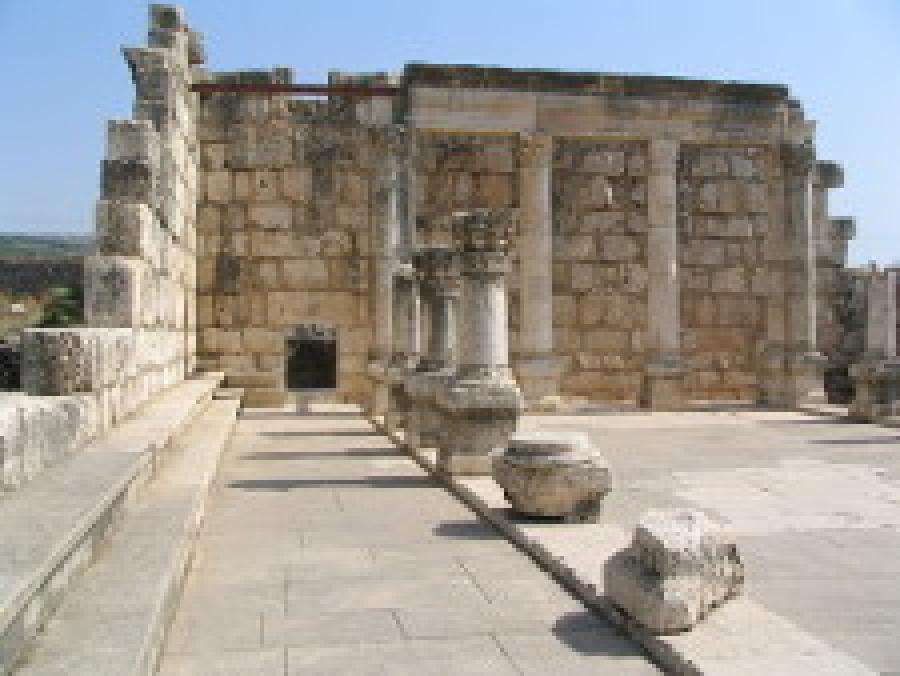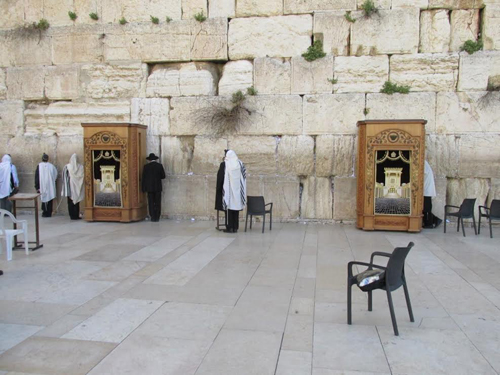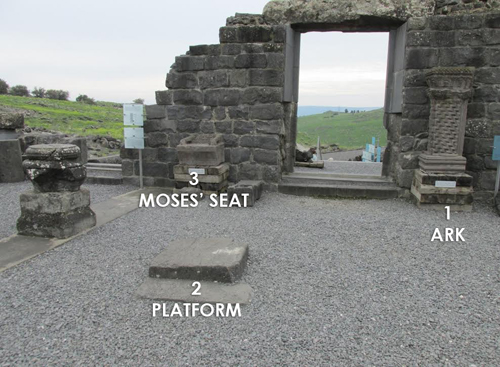The Synagogue & the Word
Image

The Capernaum Synagogue
From Faith Pulpit, Winter 2015. Used by permission.
A former graduate professor of mine made a passing statement once that grabbed my attention. He referred to two types of worship: the temple model and the synagogue model. The temple emphasized ritual and the synagogue emphasized the Word. In this companion article I want to focus on three physical aspects of the synagogue that relate to the Word of God— the ark, the platform, and Moses’ Seat.
The pictures below help illustrate these three physical features. The first image shows two arks, or special containers for the scrolls of Scripture, at the Western Wall in Jerusalem today. On Mondays and Thursdays young men have their bar mitzvah celebrations at the Western Wall. These arks are here in preparation for their reading from the scrolls at this turning point in their lives.


The second image features the ancient synagogue at Chorazin. The ark (#1) contained the scrolls of Scripture. The platform (#2) is the raised stone in the foreground. This stone is considered to be the place where the reader of Scripture stood. The seat (#3) is known as Moses’ Seat (Matt. 23:2) from which the teacher/preacher taught. Sitting was the position of Jewish instruction/exhortation as illustrated by our Lord in the Sermon on the Mount. “And seeing the multitudes, He went up on a mountain, and when He was seated His disciples came to Him. Then He opened His mouth and taught them” (Matt. 5:1, 2).
I want to take two approaches to the synagogue and the Word. First, we will use this synagogue to illustrate what the Lord did when He was rejected at the Nazareth synagogue. Then we will consider the implications of the rejection of the Lord at Chorazin, Bethsaida, and Capernaum.
Rejection at the Nazareth Synagogue
Luke 4:16–30 recounts our Lord’s attendance, reading, and sermon at the synagogue in Nazareth, which led to His rejection by his hometown. Following His consistent pattern, He attended the synagogue on the Sabbath Day. Verse 16 states He “stood up to read.” The place where He stood would have been on the raised stone platform (#2). The attendant handed Him the scroll of Isaiah, having retrieved it from the ark (#1). The Lord unrolled the scroll to what is now identified as Isaiah 61:1 and 2a,
The Spirit of the Lord is upon Me, because He has anointed Me to preach the gospel to the poor; He has sent Me to heal the brokenhearted, to proclaim liberty to the captives and recovery of sight to the blind, to set at liberty those who are oppressed; to proclaim the acceptable year of the Lord.
He then rerolled the scroll and handed it back to the attendant. Following the reading, He walked over and sat in Moses’ Seat (#3).
In verse 21 He gave a short message. “Today this Scripture is fulfilled in your hearing.” His quotation revealed He was offering Himself as Messiah, the One who would establish the kingdom. The atmosphere during the reading is stressed in v. 20. “And the eyes of all who were in the synagogue were fixed on Him.” The impact of His message was powerful. “So all bore witness to Him, and marveled at the gracious words which proceeded out of His mouth.”
At the same time the people were confused. The congregation asked “Is this not Joseph’s son?” This question led to His response concerning His person and ministry, including favorable comments about Gentiles who had positive interaction with two key Old Testament prophets. His claim of Messiahship and sentiments toward Gentiles caused the hometown people to be “filled with wrath” and to want to kill Him. His interpretation and application of the Word led to His rejection. “He came to His own, and His own did not receive Him” (John 1:11).
The Nazareth rejection was the prototype of the coming attitude and action of the whole nation. The Jewish rejection of the “acceptable year” led to a unique inclusion of the despised Gentiles in the Church Age. Now Jew and Gentile are united as one in Christ (Eph. 2:11—3:7). The “acceptable year” is now (2 Cor. 6:2).
Will the Messiah ever establish an earthly kingdom in Israel as the rest of Isaiah 61 teaches? Yes, but it will involve the rest of Isaiah 61:2 being fulfilled. The rest of the sentence reads “and the day of vengeance of our God; to comfort all who mourn.” For Israel “the day of vengeance” (i.e., the Tribulation) must accomplish its purpose. It will prepare Israel to accept Jesus as their Messiah/Savior (Zech. 12:10, 11). When they accept Him, those who mourn will receive comfort and consolation, and they will receive “beauty for ashes, the oil of joy for mourning, the garment of praise for the spirit of heaviness” (Isa. 61:2b, 3).
Jesus’ ministry of the Word directly identified Him as Messiah. The rejection of that claim indirectly portrayed His future national rejection. Stopping where He did in His reading also indirectly implied a future for Israel in which they will receive the Messiah after He takes them through the Tribulation.
The Synagogue in Chorazin
Let’s go back to the synagogue in Chorazin. Perhaps Jesus shared a similar message from Moses’ Seat there. In any case He reminded the people that they had witnessed His miracles which had authenticated Him as Messiah. Matthew 11:20–24 identifies three towns in Galilee that received special condemnation from the Lord. They have frequently been identified as the “evangelical triangle.” (If you draw lines from each of these towns to each other, you will make a rough right triangle.) Chorazin leads the list, followed by Bethsaida and Capernaum.
Christ announced it would be more tolerable for the pagan cities of Tyre and Sidon than for Chorazin and Bethsaida in the future day of judgment. He said it would be more tolerable for infamous Sodom on the day of judgment than for Capernaum. What would bring such a strong denunciation from the Lord Jesus?
When I sit in Moses’ Seat on our tours, I remind the group of the Biblical principle the Lord was stressing. The principle is summarized in Luke 12:48 “To whom much is given, from him much will be required.” One of the most serious offenses we can commit is to know truth but not respond positively. Romans 1:18 reminds us that God’s wrath is revealed against those “who suppress the truth in unrighteousness.” Chorazin and the other two towns not only had heard the Word, but they also witnessed miracles that authenticated Christ’s person and teaching. They rejected great light; hence, they were without excuse. They enjoyed much more revelation than Tyre, Sidon, and Sodom. As a result the Lord treated them accordingly.
When we think of Chorazin and the Seat of Moses, think of the accountability we have for truth we know. As another has said, “The best thing we can say to the Lord is, ‘Thy will be done’ and the worst thing we can hear the Lord say to us is, ‘thy will be done.’”
Christ’s denunciation reflects the fact that suppressing the truth as described in Romans 1 ultimately results in God giving us up to our own ways: “God gave them up” (1:24); “God gave them up” (1: 26); “God gave them over” (1:28).
The synagogue represents the teaching and preaching of the Word. The synagogue at Nazareth teaches us not to reject the Messiah. Chorazin teaches us not to reject the Messiah and His special revelation. “Then He said to them, take heed what you hear. With the same measure you use, it will be measured to you” (Mark 4:24).
Ernie Schmidt Bio
Dr. Ernie Schmidt earned degrees from Pillsbury Baptist Bible College (B.A.) and Central Baptist Theological Seminary (M.Div. and D.Min). Dr. Schmidt served for forty-eight years as a pastor and Bible college/seminary teacher and administrator. He was a faculty member and dean of Faith Baptist Theological Seminary from 2002 to 2013, and he served as interim president of FBBC&TS from January 2014 to May 2015. In addition, Dr. Schmidt has led thirteen trips to Israel and has also been to Turkey and Greece three times. Dr. Schmidt and his wife, Gen, now live in Owatonna, Minnesota.
- 130 views


Discussion